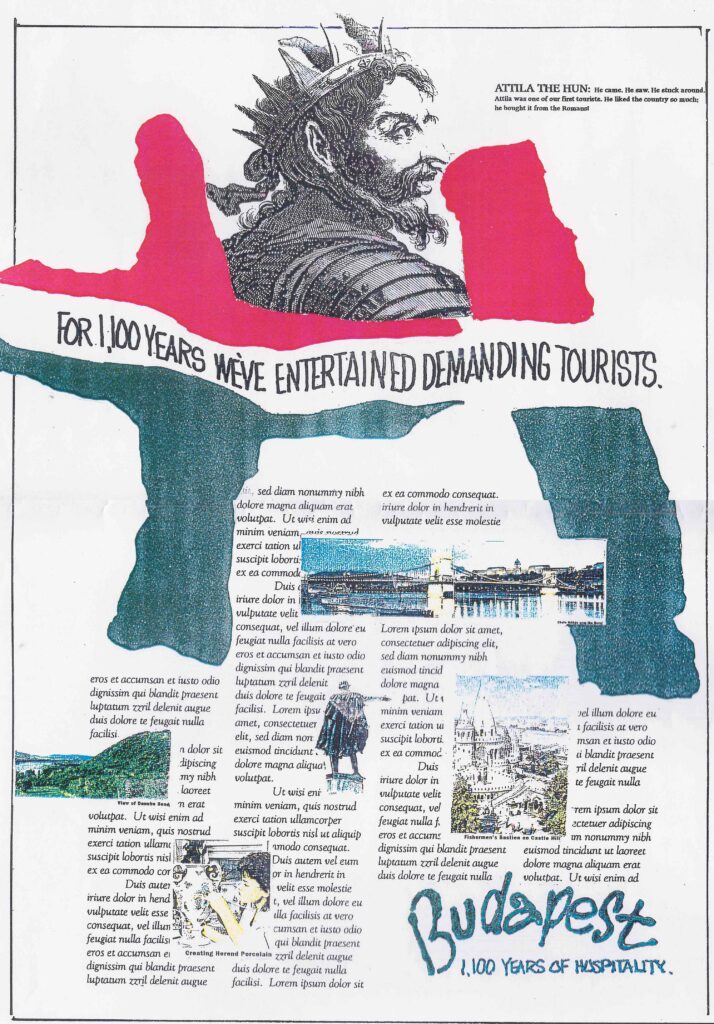A freelance assignment in Hungary came up in 1989. The country was just breaking free from Russian domination and communism, literally at that very moment. A bank in Budapest, called DunaBank, wanted to use their new entrepreneurial freedom to launch a credit card. We did this and after a couple weeks returned home.
After I got back, we were asked by people I had met there to pitch some ideas for Budapest tourism. The Eastern European market was now just being pried open for western visitors and Budapest wanted to attract North Americans with their western dollars.
We prepared two advertising directions to be used for leading U.S. magazines such as The New Yorker extoling the benefits of the culture, cuisine, and shopping that Budapest offered.
One direction proposed using 1/3 pages ads on opposite sides of a two-page spread, with high culture on one side and tourism attractions on the other – one had headlines: “Bartok” and “Bar Talk; another’s headlines were “Franz Liszt” and “Shopping List.”
The other direction, the one the Budapest Tourism Authority liked, was a large graphic of Atilla the Hun with a headline “For 1100 Years We’ve Entertained Demanding Tourists.” Our layout showed a large letter H in the Hungarian national colours. Art Direction by Brian Hannigan. The tagline reinforced the headline with “1100 Years of Hospitality.”
We thought it would be provocative and cheeky to use someone, like Attila the Hun, who instilled terror in Western thought and portray him as just an exceptionally demanding tourist. The Budapest Tourism people loved the idea.

Then, they wanted to know what a second ad might be like to extend the campaign.
We also loved the concept, so we selected another tough historical character who visited and was relevant to Hungary’s thousand years of history: Suleiman the Magnificent, the Ottoman Emperor who invaded Hungary and was repulsed. For continuity we used the same headline.
When Budapest Tourism heard this idea, they were aghast! They were shocked!
We were fired.
Turns out Atilla, for Hungarians, is the founder of the nation and a national hero. Lots of people are named in his honour.
Suleiman, on the other hand, according to the Budapest Tourism folks, was a bad guy, a Turk, who probably roasted and ate babies. He was a terrible person. He tortured people!
They didn’t want anything to do with him! He was totally unacceptable! What the heck were we thinking? We clearly had no understanding of the Hungarian market. I guess we didn’t…
We tried to convince them that what was important was how people in the West perceived these two historical figures. While Budapest Tourism had loved Attila, it was too late for us in the relationship once we mentioned Suleiman. We were unacceptable. We were done. At least they didn’t think we roasted and ate babies.
When we talk about translating ideas from country to country, we focus on the language. We need to also consider cultural mores – not just of the target of the advertising, but also the originator. What is normal and accepted in one culture is not necessarily normal or accepted in another, even if the language is the same.
Think of all the cultural misunderstandings between people in the US and England, supposedly speaking the same language. Or the differences in cultural attitudes to flags in the US or Canada. Or the appeal to patriotism in US advertising that simply would not work anywhere else.
While we may look at Attila the Hun and see a villain; in Hungary he is a founder of the country. Who is right? Well, it depends on which side you are on.
Our own cultural lens is the context within which we see everything. It is hard to view things the same way others in another culture might; but that is the key to effective persuasive communications. It requires more than empathy.